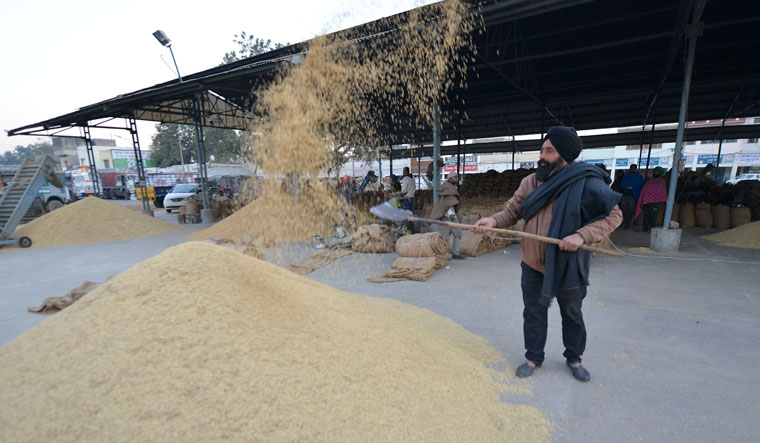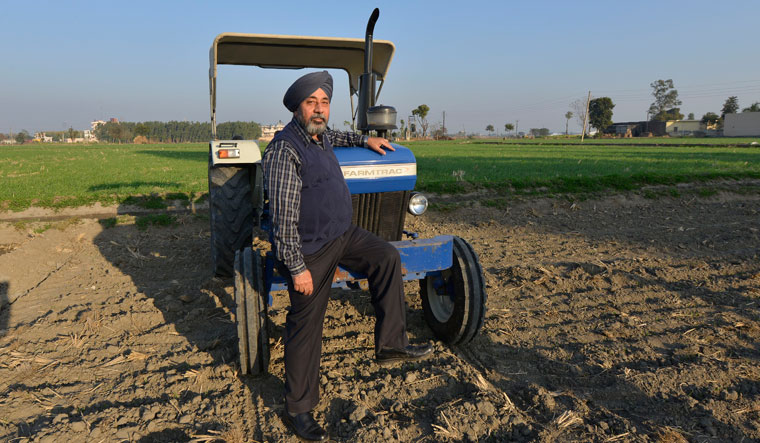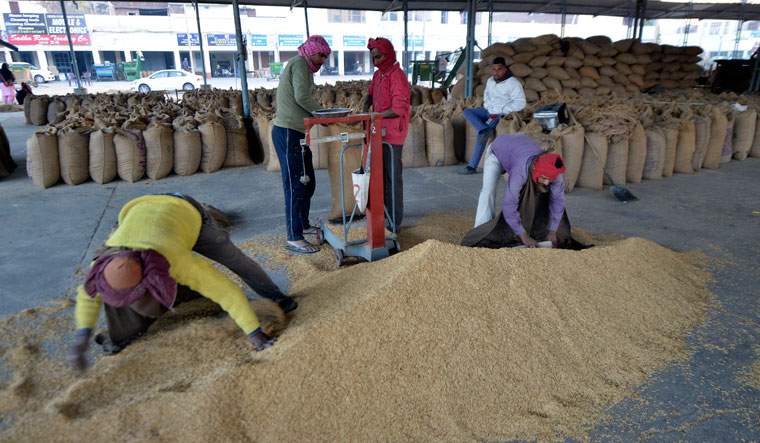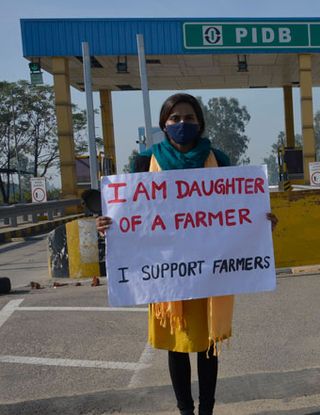Bharpur Singh sits on sacks of paddy in a tin-roofed warehouse large enough to house several hundred cars. He is scrolling through his smartphone to kill time, and looks up occasionally to check whether anyone is calling him. He has come from Jatana Ucha village in Punjab’s Fatehgarh Sahib district to sell his basmati at the mandi in Khanna, a town on the Grand Trunk Road from Amritsar to Delhi.
It is a Friday evening, and Asia’s largest grain market is numbing cold. Sudden icy winds from the Shivalik mountains in the north have plunged the temperature to 7 degrees Celsius from 18 degrees a few hours ago. “I am planning to go to Delhi soon to join the morcha (farmer protests),” says Singh, who is in his mid-forties. “The government has done us injustice.”
His face lights up as someone calls his name. A man transformed, he rushes for a tractor trolley parked nearby and brings a winnowing machine to remove dirt and chaff from the basmati rice he had harvested two months ago. It is a high-yield variety of basmati, known as 1121, that he had grown in a portion of his 10-acre farm. After winnowing, it weighs 30 quintals. It would be auctioned the next morning. The buyers are usually rice brand owners.
Known for its fragrance and length, the 1121 basmati costs Rs3,000 a quintal. It was developed in 2003, and it soon became a leading choice of farmers in Punjab, Haryana, Himachal Pradesh and Uttar Pradesh. The 1121 basmati fetched more than Rs4,500 a quintal two years ago, before US sanctions hurt Iran—the biggest importer of Indian basmati.
Unlike paddy, basmati is not part of the government’s MSP (minimum support price) system, which covers 23 crops and gives farmers an assured income. The government announces MSP twice a year, but procures only wheat and paddy through designated market yards, known as agriculture produce marketing committees (APMCs). The system was set up in the 1960s.
There is no price guarantee for the other 21 items in the MSP system, since the government does not procure them directly. Farmers sell their produce to private players at market prices. Often, the wholesale prices are lower than the MSP, provoking farmers to dump their harvest on roads in protest.
In 2020, the government procured 449.83 lakh metric tonnes of paddy till December 25—an increase of 25 per cent over the previous year. Punjab contributed 45 per cent of the total procurement. “I tried growing different crops like moong dal, sugarcane, maize and basmati, but the price fluctuates despite the MSP for them,” says Bharpur Singh. “The current MSP for moong dal is Rs7,128, but I got only around Rs3,000. When there is no guarantee of recovering production costs, we have no choice but to plant only wheat and paddy.”
There are 154 main APMC mandis and 1,820 purchase centres in Punjab. But one of the three new farm laws—the Farmers’ Produce Trade and Commerce (Promotion and Facilitation) Act—allows private players to bypass APMC mandis and directly buy produce from farmers. This means that the mandis will lose their prominence in the procurement process. Farmers like Bharpur Singh are worried that they would lose their assured income.
Bharpur Singh talks about what happened in Bihar, which abolished APMC mandis in 2006. Farmers there now sell directly to traders and corporates. Even though the MSP for paddy is Rs1,868 a quintal, the market price in Bihar hovers below Rs1,000. Punjab has registered more than 80 cases in the past few months, after seizing hundreds of trucks of paddy brought from Bihar to be sold in APMC mandis in Punjab. The influx of paddy from Bihar had created a curious situation—Punjab procured more paddy than it produced. What riled the Punjabi farmers was that even the state’s rice mills were buying paddy from Bihar at rates lower than the MSP.
Bharpur Singh is also worried that the new agriculture contract law—the Farmers (Empowerment and Protection) Agreement on Price Assurance and Farm Services Act—would enable corporates to take control of his land. He fears that he would have no recourse to justice. Under the new farm laws, arbitration powers rest with sub-divisional magistrates, whom farmers fear corporates would easily influence.
Such concerns have led thousands of farmers from Punjab to lay siege to Delhi seeking repeal of the new laws. Punjab and Haryana are the states that will be most affected by the weakening of APMCs and the MSP system. These two states earn around Rs2,700 crore a year as taxes and levies.
Farmer unions have been educating people on how the new laws would affect them. What started as regular protests have since galvanised into a widespread agitation against the authorities. After forcing their way through police checkpoints, a cavalcade of tractor trolleys reached the Singhu border, a gateway to Delhi. Singhu has a memorial to Guru Teg Bahadur, the ninth Sikh guru who sacrificed his life to protect Hindus from the Mughals. A symbol of resistance, the memorial is less than 100 metres from the huge camp the protesting farmers have built. It was at the Singhu border that Punjab rediscovered its Punjabiat. Sacrifice had met service.
Resistance is ingrained in the psyche of Sikh peasantry. Punjabis from all walks of life have pitched in, turning the protests into a spectacle of defiance. Ideologies of all political, social and religious hues have united behind the protesting farmer. Any “assault” on agriculture is interpreted as an attack on the Sikh faith and culture. Every day, buses and trolleys bring ‘pilgrims’ to the protest sites on Delhi’s borders. The caravan of trolleys stretch as far as 30 kilometres. Farmers from Haryana have also joined, though they are hardly visible in the sea of turbans.
If the number of protesters is any indication, the Union government has found a formidable adversary. Parallels are being drawn between the farmer protest and the historic Sikh morchas: the Guru ka Bagh Morcha in 1922 for ownership of a gurdwara in a village near Amritsar; Jaito Morcha in 1924 for restoring the rule of Maharaja Ripudaman Singh of Nabha; and Morcha Chabian for recovering keys to the Golden Temple treasury.
The Union government is dealing with the issue at two levels. It is both engaging with the farmers and trying to divide and isolate them into groups—as farmers from Punjab and elsewhere, for instance. Prime Minister Narendra Modi has been highlighting the benefits of the new farm laws. But the farmers are sticking to their demand that the laws be repealed. And, the groundswell is preventing farmer union leaders from withdrawing.
Punjab is closely watching what is happening in Delhi. The verdant wheat fields and the sweet smell of jaggery being prepared next to the sugarcane fields belie a seething anger. New Punjabi songs are filled with open challenges to “Dilli”. Stickers and flags declaring ‘No Farmers, No Food’ have become so common that even luxury cars sport them.
Also read
“Sikhs have a history of resistance, which is visible in these protests,” says Prof Gurdarshan Singh Dhillon, a Sikh historian. “It is much beyond the farmer issue. It is a fight for the diversity of the country. It was promised before independence that India would be demarcated on linguistic and cultural basis. What the government is trying to do is make ‘one culture, one language’. These protests are a cumulative expression.”
Farmers, predominantly Jat Sikhs, have been the dominant force among the Sikhs. The protesters invoke cultural metaphors drawn from erstwhile religious agitations, military campaigns and sacrifices of the gurus. “This is part of the Sikh ethos; it’s a way of life. It is from where the Sikhs draw their strength and morality,” says Dhillon.
Where are the farmers drawing money and material from? “Guru Nanak has given a key mantra to the Sikhs: kirt karo, vand chako, aur naam japo. Honest labour, fair distribution, and then prayers. These principles are part and parcel of the Sikh ethos,” says Dhillon. “You read this with uttam kheti, madh vapaar, nakhid chaakri, which means agriculture is supreme, then comes business, and finally slavery or a job. When agriculture is given such respect, people are ready to do anything to save it.”
What do the cultural and historical references signify? “People argue that historically Punjab had a conflict with the Delhi durbar, starting from the Mughals,” says Harish Puri, former professor of political science at Guru Nanak Dev University in Amritsar. “When gurdwaras talk about sacrifices of the gurus, and the incidents are invoked every day, they have an impact. But the current farmer leadership has been cautious not to [let the radical side] hijack the movement in any way.” Puri says these protests have also become a cumulative expression of all resentments against the Modi government.
The community’s sense of victimhood is palpable. The farmers look at the new laws as an attack on the federal structure of the state. They also deeply fear the possibility of corporates usurping their land. “My father served in the British Indian army and was bestowed the rank of Sardar Bahadur. He won a military cross,” says Baldev Singh, 76, of Barudi village in SAS Nagar district. “We got 125 acres, much of which was sold at that time. Now we have around 10 acres and nothing else.”
Every day, Baldev and fellow farmers from neighbouring villages gather at a highway toll plaza for a sit-in. Similar sit-ins have been going on across Punjab. The protesters commemorated December 20 as martyrs’ day. Pictures of 32 farmers who died since the protests started have been put up at all toll plazas in Punjab. Martyrdom is a common theme that binds key events in Punjab’s history. Observers say that the yearlong celebrations of Guru Nanak’s 550th birth anniversary, along with the opening of the Kartarpur corridor, had boosted the “community sentiment”.
Villagers are taking turns to go to Delhi, so that those who have been staying there can return. Food is being prepared and cash donations are collected. “We have assured families of people who have gone to the morcha that we will take care of their crops,” says Baldev Singh. “It is a fight for survival.”
Swarn Singh of Dhakron Khurd village says the focus is on Singhu border. “But it’s at Tikri border that we hear of shortages. We have collected money to send there,” he says.
The government says the new laws affect only rich farmers who have gained disproportionately from the MSP regime. But Swarn Singh, who owns five acres, says smaller farmers are the most affected. Big farmers have already diversified into related businesses like transport and cold storage, or are active politically. “Without the arhtiyas (commission agents in APMCs) and the big farmers, the smaller farmers cannot survive. The new laws affect the smaller farmers the most,” says Swarn Singh.
The grain market in Khanna, spread over 50 acres, has around 200 arhtiyas. A municipality in the prosperous Ludhiana district, Khanna derives its name from a Punjabi word that means one-fourth. According to folklore, the wife of a neighbouring royal received one-fourth of a property. The area came to be called Khanna. (The name has no relation to the Khanna surname.)
The new laws aim to abolish the role of arhtiyas, allowing private players to buy from farmers directly. At grain market in Khanna, most of the arhtiyas have been absent for days. The income tax department had raided the houses and offices of several prominent arhtiyas across the state, especially those who had vocally supported the farmer protests.
“This is our third generation in this business,” says Sanjay Ghai, 61, former president of the Khanna arhtiya association. “Our grandfather became an arhtiya and bought food grains, jaggery and pulses. Before the government started buying from here, the wheat used to go to Mumbai. I remember going to Mumbai along with my father to sell grains there.”
He remembers the green revolution changing the agriculture profile of the state. The Ghais had an oil factory where they pressed locally grown groundnut. “[During the green revolution] the farmers used tractors to flatten all sandy hills,” he says. “They transformed the area and started sowing wheat and paddy. We shut down our oil mill, as farmers stopped cultivating groundnut. I now have a rice mill.”
There are more than 27,000 registered arhtiyas in the state. Many of them have two-storey shops that provide accommodation to farmers during the procurement season. They are often compared to Sukhilala, the greedy money lender in the 1957 film Mother India, played to perfection by actor Kanhaiya Lal. But the reality is different. “[Former Union minister] Sushma Swaraj called us farmers’ ATM,” says Ghai. “Our doors are always open to farmers who need money and other help—be it for a marriage in their family or a health emergency. We go out of our way to help them. These relations sustain us.”
The arhtiyas charge 2.5 per cent from the buyer as commission, while government takes 6 per cent as “development charges”. The farmer, however, gets full MSP for his produce. “We are service providers,” says Raman Singh, an arhtiya in Khanna. “We buy machines, employ workforce, and provide jute bags for cleaning and bagging the crop—all with this 2.5 per cent commission. The farmer is paid in advance, while we take the risk with the buyer.”
Many arhtiyas have diversified intro related activities, and are better prepared and politically connected than small farmers to absorb any economic change that a free-market system may bring.
Like most farmers, Bharpur Singh also depends on arhtiyas. “I take money [from them] for family needs,” he says. “My daughter is in class 12 and is preparing for IELTS exams. My younger son wants to join the Army like his grandfather did. It is customary for zamindars to gift a car when a daughter gets married. [All this needs money.] I am what my land is; without it, I am nobody.”
As jobs are scarce or unattractive, youth in Punjab have been migrating out of India. “We are thankful to countries like Canada, Australia and New Zealand for accepting Punjabis,” says Raman Singh. “That is where we are finding our glory again.”
The MSP system has been a lifeline for farmers for six decades. It brought them prosperity, and preserved the cultural and social systems in Punjab. The enactment of farm reforms without consulting the farmers has fuelled the suspicion that this way of life was under threat.
A flip side is that the MSP system has been a cushion for complacent governments, which failed to modernise agriculture. “MSP is a trap,” says Manjit Singh Kang, renowned plant geneticist and former vice chancellor of Punjab Agriculture University in Ludhiana. “It doesn’t allow farmers to opt for other crops.”
An adjunct professor at Kansas State University, Kang lives in Ludhiana with his wife, who is a scientist from Tamil Nadu. “MSP is unfair to farmers of food bowl states like Punjab and Haryana,” he says. “The price is calculated on an all-India basis, but farmers here spend much more on their crops. These farmers are going to produce even if there is drought. They will run tube wells even if there is no electricity; they will use diesel. Moreover, the wheat produced here has 11 per cent of protein, whereas in other states it is 7 per cent. MSP should be on a regional basis. Why not pay them more for better quality crop?”
According to him, the government was trying to change a system that was working well. “The government hooked the farmers from Punjab, Haryana and Uttar Pradesh on MSP for ensuring food security. The farmers have done well. I wonder if corporates will be able to better their production,” he says.
Rice is not native to Punjab, but the state took to growing the grain. Rice drains the state’s groundwater reserves. “The green revolution is not sustainable,” says Kang. “Yields are not going up. If ecology goes wrong, everything will go wrong. The government is encouraging a second green revolution, increasing the productivity of eastern states. My argument is, if we save the grains we waste, that will in itself be a green revolution. To encourage diversification, the government should buy other crops on MSP.”
According to the government, there are 34 tube wells per square kilometre of net sown area in Punjab. The state’s policy of giving free power, with MSP, for paddy cultivation has led to indiscriminate use of groundwater. Experts suggest that paddy cultivation be cut down by half, and the vacated land be used for cultivating vegetables and fruits. And enough cold storage be set up to allow farmers to sell crops when the price is right.
Kang says the government should have talked to the farmers before enacting the new laws. NITI Aayog called a meeting of farmer leaders in 2017 but they felt they were not really heard. They were told that the corporates would rent their land to ensure better output. “Now, you don’t tell the farmers that someone else can do a better job than them. You know the reaction now,” says Kang.
The current agitation may force policymakers to notice the progressive changes farmers have already initiated. Pavitar Singh Pangali, vice president of the Punjab Agricultural University’s farmers club, says he has been helping fellow farmers adapt to changes in farm technologies and processes. With three tractors and some workers, Pangali has been cultivating vegetables, wheat, paddy and lentils. He is planning to plant bamboo to help the National Bamboo Mission.
“I have attended all courses that the agricultural university holds for farmers,” he says. “I use the latest, high-quality variety of wheat recommended by the university. None of the 7,500 members in the farmers club have been driven to suicide.”
Pangali says the government can do a lot for farmers. “Our oil import bill is huge—Rs80,000 crore. Canola oil is imported even though we can produce it here locally. I produce my own oil. If government makes ethanol production mandatory for all sugar mills, the oil can be sold at petrol pumps, which in turn can help sugar mills tide over payment crises. More farmers will be planning sugarcane, instead of paddy and wheat.”
Hostile India-Pakistan relations have affected farmers in Punjab. “We exported so much to Pakistan, and many middle-eastern countries,” says Jagbir Singh of Salana village. “The prices have come down because of the ban on trade. Strained relations with Pakistan always affect Punjab the most.”
Jagbir’s nephew Harmanjot Singh, a mechanical engineer in his early twenties, says he decided to return to farming as there were hardly any well-paying jobs. “I was getting Rs10,000, which we were paying to labourers on our farm,” he says.
Farmers in Punjab distrust the government’s promise of retaining the MSP system. The influx of workers from Bihar during the cropping season only adds to their distrust. Many of the labourers own more farmland back home in Bihar than the farmers who employ them in Punjab. Dhirendra Kushwaha, a labourer who hails from Bihar’s Bettiah district, owns more than six acres. “We cannot earn enough from our farms,” he says. “Our farm is near the Gandaki river, so there is a constant threat of flooding. The vegetables we grow do not fetch a good price.”
The farmers laying siege to Delhi’s borders are in it for the long haul. The caravan of trolleys has gone too far to return without scoring a victory. There are, however, fears that the victory itself could be Pyrrhic. “I am worried that this anti-corporate sentiment may harm the state, as investments may dry up,” says Puri. “Punjab is in trouble because of crumbling economy, joblessness, and lack of industries.”
Whatever the outcome of the farmer agitation, one thing seems certain: it would end up drastically changing Punjab.







